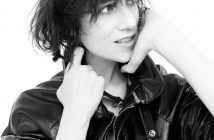By William Lee Adams, Time.com, Paris Monday, Feb. 01, 2010
Wispy and delicate, Charlotte Gainsbourg rushes into the lobby of Paris’ Hotel Montalembert looking like she might collapse under the weight of her enormous fur coat. Seeing two representatives from her record label, she delivers four decidedly froid air-kisses. « No more interviews, » she says, clearly exhausted from the weeks she has spent promoting her new album IRM. Once upstairs in a suite, however, she seems to relax, stripping down to a T-shirt and crouching on her knees, sphinx-like. Would she like the sofa or a chair, perhaps? « Non, » she says. « The floor is fine. »
Revered as one of France’s finest actresses — and now one of its most successful singers, too — Gainsbourg, 38, can sit wherever she likes. Since making her screen debut as a 13-year-old alongside Catherine Deneuve in the 1984 film Paroles et Musique, she’s racked up 37 movie credits, including critically acclaimed turns in 21 Grams and Antichrist, which earned her a Best Actress Award at the Cannes Film Festival last year. But despite these successes, she’s still known primarily as the daughter of Jane Birkin, the gamine English model and actress, and Serge Gainsbourg, France’s beloved singer-songwriter. When Serge died in 1991, the nation went into mourning and President François Mitterrand lauded him as « our Baudelaire, our Apollinaire. » Carrying such celebrated DNA can be a daunting task. « With acting I never have to reference my father, » Gainsbourg says. « With music I want to refer to him, but I want to find my own path, too. »
Of course, Gainsbourg is lucky she’s got her father’s musical genes to fall back on. The path that many actresses follow from the movie set to recording studio is lined with misplaced ambitions and audible trauma — remember Lindsay Lohan’s and Scarlett Johansson’s disastrous efforts? But Gainsbourg has made the transition effortlessly. Her 2006 album 5:55, a collaboration with Radiohead producer Nigel Godrich, topped the French charts, with critics praising her as a true chanteuse. For her latest album IRM — which will be released on Jan. 26 in the U.S. and most of Europe — she teamed up with eclectic alt-rocker Beck. « He wrote all of the music and lyrics, but we really had an exchange. The album is very close to me, » she says. In sessions at Beck’s studio in Los Angeles, Gainsbourg tried to inspire him with books like Through the Looking-Glass. He played her beats, watched her react and then « guessed » what she wanted to sing about.
In typical Beck style, the collaboration cuts across a variety of different musical styles — blues, electronica, rock and folk. And Gainsbourg proves she’s more than just his muse. Although her vocals sometimes sound like mere whispers, she conveys intense emotion throughout the album. On « Le Chat du Café des Artistes, » — the only song sung entirely in French — her dark intonations complement the song’s haunting strings. On « Voyage, » she channels Enya at a drum circle — and somehow manages to give the song a spiritual quality.
The most intimate track on the album is « IRM » — that’s French for an MRI scan — which pulsates with clanging industrial beats. In 2007, Gainsbourg suffered a brain hemorrhage in a waterskiing accident and surgeons had to drill through her skull to save her. Despite recovering fully, she insisted on undergoing MRI scans for several months after the accident. « The sounds inside the machine are nasty to hear, » she says. « They’re brutal and aggressive, and rhythmically very chaotic. But they’re also musical. » The lyrics on « IRM » address her attempts to exorcise her medical demons: « Leave my head demagnetized/ Tell me where the trauma lies/ In the scan of pathogen/ Or the shadow of my sin. »
As part of her recuperation, Gainsbourg also accepted a role in Danish director Lars von Trier’s controversial thriller Antichrist, which she filmed in between sessions with Beck. In the movie, she plays a woman who descends into madness after her infant son dies: she bangs her head against a toilet, masturbates naked in a forest and mutilates her own genitals. « The film was so dramatic and so extreme that it took all my thoughts away, » she says. « It helped me recover. » Von Trier still struggles to reconcile her raw performance in the movie with her soft-spoken manner in person. « Privately she is so shy. You can sit through a meal with her and she doesn’t say anything, » he says. « How can this very, very shy person do scenes like this? »
Gainsbourg doesn’t have a straight answer, but she says the graphic scenes didn’t faze her. « I felt more naked crying and howling than I did showing my bottom, » she explains. Then again, her father did give her an early education in provocation. His infamous 1969 duet with Birkin, « Je T’Aime … Moi Non Plus, » was banned by the Vatican because of its salacious lyrics and feigned orgasms. And in 1984, he recorded « Lemon Incest, » a duet in which he and a 13-year-old Charlotte sing that « the love that we will never make together is the most beautiful. » In the video, they lie together in bed, Serge shirtless and Charlotte wearing nothing but panties and a shirt. Critics claimed it was a celebration of incest and pedophilia, but the song rocketed up the French charts.
« It’s about the pure love of a father and a daughter, » she says, defending the song all these years later. « There was a lot of shyness about frankly saying, I love you. My father would say it to other people and through song, and wanted me to know it through other people as a public thing. » (Read about Serge Gainsbourg in the pages of TIME in 1980.)
Gainsbourg doesn’t stir controversy on IRM, but her father’s influence can still be felt. By pursuing a highly personal and unconventional musical path, she pays homage to his legacy. And, as he would have wanted, she’s creating one of her own.



